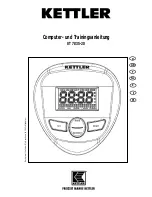
10-128
KDFX Reference
KDFX Algorithm Specifications
Roto InOut
When set to
In
the rotary speaker is active; when set to
Out
the rotary speaker is
bypassed.
Dist Curve
Controls the curvature of the distortion.
0%
is no curvature (no distortion at all). At
100%
,
the curve bends over smoothly and becomes perfectly
fl
at right before it goes into
clipping.
DistWarmth
A lowpass
fi
lter in the distortion control path. This
fi
lter may be used to reduce some of
the harshness of some distortion settings without reducing the bandwidth of the signal.
DistLPFreq
Controls one-pole lowpass
fi
lters in the
PolyEQ
(in
VC+Dist+HiLoRotr
).
Without the lowpass
fi
lters, the sound tends to be too bright and raspy. With less
distortion drive, less
fi
ltering is needed. If you turn off the distortion curve (set to
0%
),
you should turn off the lowpass
fi
lter by setting it to the highest frequency.
Cabinet LP
A lowpass
fi
lter to simulate the band-limiting of a speaker cabinet. The
fi
lter controls the
upper frequency limit of the output.
Xover
The frequency at which high and low frequency bands are split and sent to separate
rotating drivers.
Gain
The gain or amplitude of the signal passing through the rotating speaker.
Rate
The speed of the speaker rotation.
Size
The effective size (radius of rotation) of the rotating speaker in millimeters. Affects the
amount of Doppler shift or vibrato of signal.
Tremolo
Controls the depth of tremolo of the signal. Expressed as a percentage of full scale
tremolo.
Beam Width
The rotating speaker effect models the acoustic radiation pattern of a speaker ranging
from omnidirectional (radiates in directions in equal amounts) to a wide beam. You may
adjust the beam width from
45°
to
360°
. If you imagine looking down on the rotating
speaker, the beam angle is the angle between the -6 dB levels of the beam. At
360°
, the
speaker is omnidirectional.
Resonate
A simulation of cabinet resonant modes expressed as a percentage. For realism, you
should use very low settings.
Res Dly
The number of samples of delay in the resonator circuit in addition to the rotation
excursion delay.
Res Xcurs
The number of samples of delay to sweep through the resonator at the rotation rate of the
rotating speaker.
Res Phs
This parameter sets the relative phases the resonators. The angle value in degrees is
somewhat arbitrary and you can expect the effect of this parameter to be rather subtle.
Lo Gain
The gain or amplitude of the signal passing through the rotating woofer (low frequency)
driver.
Lo Rate
The speed of the woofer rotation.
Dist Drive or
Tube Drive
Applies a boost to the input signal to overdrive the distortion algorithm. When
overdriven, the distortion algorithm will soft-clip the signal. Since distortion drive will
make your signal very loud, you may have to reduce the Out Gain as the drive is
increased.
Summary of Contents for K2661
Page 18: ...2 4 LFOs LFO Shapes...
Page 34: ...3 16 DSP Algorithms...
Page 54: ...5 4 MIDI Note Numbers Note Numbers for Percussion Keymaps...
Page 72: ...7 10 System Exclusive Protocol K2661 System Exclusive Implementation...
Page 82: ...9 4 Upgrading Sample Memory Choosing and Installing a SIMM for K2661 Sample Memory...
Page 334: ...10 252 KDFX Reference KDFX Algorithm Specifications...
Page 340: ...11 6 Glossary...
Page 382: ...12 42 Triple Modular Processing Alphanumeric Buttonpad Entries for DSP Functions...
Page 392: ...B 6 SysEx Control of KDFX MSB and LSB...
Page 442: ...D 20 Contemporary ROM Block Objects Controller Assignments Contemporary ROM Block...
Page 490: ...H 12 General MIDI Standard Mode Controller Assignments...
Page 492: ...I 2 Live Mode Objects Live Mode Programs...
Page 498: ...K2661 Musician s Reference Index...
Page 500: ......
















































